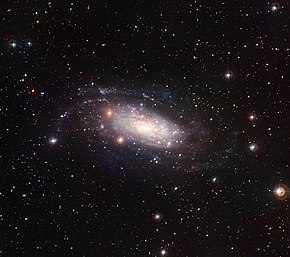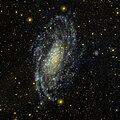| NGC 3621 | |
|---|---|
 NGC 3621 taken by the Wide Field Imager (WFI) at ESO's La Silla Observatory | |
| Observation data (J2000 epoch) | |
| Constellation | Hydra |
| Right ascension | 11h 18m 16.52s[1] |
| Declination | –32° 48′ 50.7″[1] |
| Redshift | 0.002435 ± 0.000007[2] |
| Heliocentric radial velocity | +727[3] km/s |
| Distance | 21.7 million light years (6.64 Mpc)[4] |
| Apparent magnitude (V) | 10.0 |
| Characteristics | |
| Type | SA(s)d[1] |
| Mass | 2 × 1010[1] M☉ |
| Other designations | |
| UGCA 232, MCG -05-27-008, PGC 34554[5] | |
NGC 3621 is a field spiral galaxy about 22 Mly (6.7 Mpc) away[4][6] in the equatorial constellation of Hydra. It is comparatively bright and can be well seen in moderate-sized telescopes. The galaxy is around 93,000 ly (29,000 pc) across and is inclined at an angle of 25° from being viewed edge on. It shines with a luminosity equal to 13 billion times that of the Sun.[7] The morphological classification is SA(s)d,[1] which indicates this is an ordinary spiral with loosely wound arms.[8] There is no evidence for a bulge.[9] Although it appears to be isolated,[8] NGC 3621 belongs to the Leo spur.[7]
This galaxy has an active nucleus that matches a Seyfert 2 optical spectrum, suggesting that a low mass supermassive black hole is present at the core. Based upon the motion of stars in the nucleus, this object may have a mass of up to three million times the mass of the Sun.[9]
![Part of NGC 3621 imaged by HST.[10]](https://upload.wikimedia.org/wikipedia/commons/thumb/a/a7/NGC_3621_HST.jpg/120px-NGC_3621_HST.jpg)
![Very Large Telescope image of NGC 3621.[11]](https://upload.wikimedia.org/wikipedia/commons/thumb/9/9e/NGC_3621_ESO_VLT.jpg/120px-NGC_3621_ESO_VLT.jpg)



